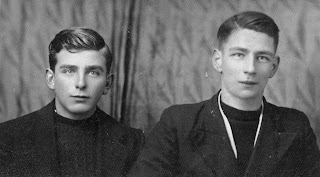I had left the butcher’s shop before rationing commenced [7th March 1940], to start work at the Reliance Furniture Company, a furniture shop near St. Peter’s Church in Sheringham.
I was taking over from an ex-soldier, Geoffrey, who had been invalided out of the army and found the work too much. I soon got the hang of the job and Geoffrey was kept on until I was able to drive the furniture van. You didn’t have to pass the driving test then, and I held a provisional licence.
 |
| LHS: Site of the former Reliance Furniture Company |
The shop sold all kinds of furniture, second-hand and new; also prams and carpets. I would deliver all over North Norfolk. Once a month, for one day, I would take cod liver oil and orange juice round the villages; mostly to the District Nurses for the babies of the area. Sometimes we had a furniture moving job, as although it was war time, people were still moving about for war work.
I had another man come with me who was a furniture maker and restorer. Charlie Harold came with me on many jobs and we sometimes got lost in the country as we only had a slit for a headlight and some of the signposts were gone.
Joining the Navy
In the early autumn of 1941 some of my friends were called up for war service. I and Sid Emery, son of the local boat builder, wanted to get in the Navy and so decided we would volunteer and not wait to be called up.We were told that we stood a better chance of getting in the Navy by volunteering for the war service as we were both a few months short of call-up age, 18. A few days after applying we were told to report to Martinau Hall in Norwich for our medical.
 |
| Sid Emery (L) and Henry at the time of applying to join the Navy in 1941 |
I continued driving the furniture van when required. When we had been on a long job of moving, after parking the van for the night, I had to let my boss George Smith know. George lived with his wife and daughter in Cremer Street.
On this night in January 1942, I called on him to let him know that all was well. He was sat next to the fire with his wife and daughter and he said “I’ll see you in the morning”. That was the last I saw of him alive. I was back in Gun Street when we heard a huge explosion and we knew it was a bomb because of the sound of aircraft, but where had it struck?
One of the fishermen came round to say it was Cremer Street that got it, and that uncle Henry Willie and cousin May were alright. We hurried round like many others. It was the very house that my boss lived in that got it, with two more houses.
 |
| Cremer Street with site of the Smith’s house marked |
A group of us found George Smith and his wife and daughter just where I had last seen them an hour, maybe more, before.
Henry’s cousin May described the scene in her book “Shannocks in Wartime”:
“The road was covered with snow and ice and it was freezing cold. Some people had collected in the road, and soldiers and civilians were clambering over the mounds of rubble the bombs had caused. The first victims were just four houses away from us at the corner of Salisbury Road. Mr. and Mrs. George Smith and their daughter Peggy had been seated at their dining table when the bomb hit; now they were all dead…Mr. Smith had a furniture business… and my young cousin, Henry West, worked for him at the time. I could see him among the group of helpers…. How they managed to do their job with everything in total darkness I do not know…. The digging for the bodies went on all night….”
I had enjoyed working for George, both in the shop and driving.
I continued to work at the furniture shop, while the other partner Gussy Larke, who lived nearby in Gun Street, sorted out the business of closing down the shop. Most of the furniture was sold at auctions. We were also moving furniture that the firm had already taken orders for.
Home Guard
During my work at the butchers and furniture shop, I joined the Home Guard with the other chaps of my age. We had our Head Quarters in St. Peter’s Road.
 |
| LHS: Location of HQ of Sheringham Home Guard |
After work we would meet at HQ, get the orders for the night and were detailed off into sections. Six of us would march along the Cromer Road to the Parson’s House, then down the lane to the railway hut where we would arrange watches in pairs, walking the cliffs from Beeston to West Runton.
 |
| HQ of Henry’s Home Guard Section |
After the night’s patrol, it was back home to start work each day.
Grateful thanks to Jonathan Emery for useful discussions.